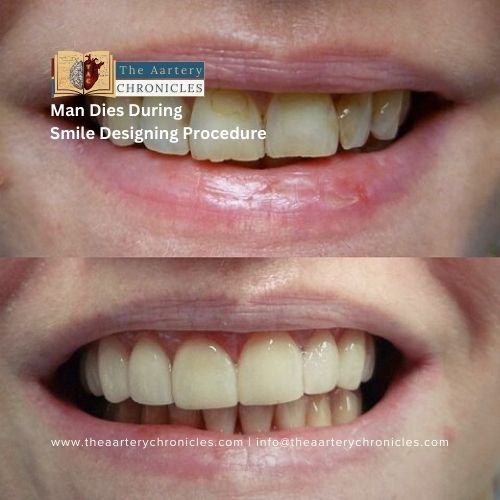

Tragedy Strikes: Hyderabad Man Dies During Smile Designing Procedure
The tragic incident during smile design in Hyderabad raises concerns about the safety and efficacy of procedures in cosmetic dentistry.
In a devastating turn of events, Laxmi Narayan, a 28-year-old groom, passed away during a smile-designing procedure mere days before his impending wedding in Hyderabad, India. At the FMS International Dental Clinic in Jubilee Hills on February 16, the smile-enhancing surgery took a tragic turn.
Ramulu Vinjam, the father of Laxmi Vinjam, has claimed that his son’s demise was caused by anesthesia overdose. He stated that the situation escalated when his son lost consciousness during the surgical procedure. Although the clinic staff contacted Ramulu Vinjam and made efforts to transfer Laxmi to a nearby hospital, unfortunately, he was pronounced dead upon arrival.
The incident has sent shockwaves through the community and prompted questions regarding the safety and regulation of cosmetic dental procedures and the efficacy of local anesthesia.
What is a Smile Design Procedure?
A smile design procedure, also known as cosmetic dentistry or aesthetic dentistry, refers to a range of dental procedures aimed at enhancing the appearance of a person’s smile. The goal of smile design is to improve the overall aesthetics of the teeth, gums, and mouth, often resulting in a more attractive and confident smile.
A smile design should always incorporate an assessment of both facial and dental composition. Some common procedures involved in smile designing include:
1. Teeth whitening
This procedure involves the use of bleaching agents to lighten the shade of teeth, removing any stain or discoloration caused by dietary habits, smoking, age, or any traumatic injury.
2. Dental Veneers
Dental veneers, also known as laminate veneers, are custom-made shells that are bonded to the front surface of the teeth to enhance their appearance. They can be used to correct issues such as chipped, stained, or misaligned teeth.
3. Dental Crowns
Dental crowns, also known as tooth-shaped caps, are placed on compromised or decayed teeth to rehabilitate their shape, size, and durability.
4. Dental Implants
Dental implants are artificial tooth roots made of titanium or other biocompatible materials that are surgically placed into the jawbone. They are used to replace the missing teeth and restore the aesthetics of the smile, improving speech and chewing abilities.

5. Orthodontic Treatments
Orthodontic treatments such as braces or clear aligners are used to straighten misaligned teeth and correct bite issues, resulting in a more symmetrical and aesthetically pleasing smile.
6. Gum Contouring
Also known as gum reshaping, this procedure involves the removal of excess gum tissue to improve the appearance of a gummy smile or uneven gum line.
What is a Local Anesthesia Overdose?
Local anesthesia (LA) is commonly used in a variety of medical and dental procedures. Local anesthetics are medications used to block nerve signals in a specific area of the body, resulting in a temporary loss of sensation.
Local anesthesia overdose, also known as local anesthesia systemic toxicity (LAST), occurs when local anesthetic medication enters the bloodstream in excessive amounts, leading to toxicity throughout the body. Although the adverse effects are rare, LA toxicity symptoms can vary from mild reactions to major cardiac or central nervous system (CNS) complications.
1. Cause And Risk Factors of Local Anesthesia Overdose
Accidental intravascular injection when administering local anesthetics has long been recognized as the most prevalent cause of local anesthesia systemic toxicity. Certain co-morbidities like cardiac disease, hepatic dysfunction, pregnancy, and metabolic syndrome increase the risk of LA overdose and, in turn, systemic toxicity.
2. Signs And Symptoms of Local Anesthesia Overdose
Some signs and symptoms of LA overdose include
CNS toxicity:
- Agitation
- Disorientation
- Dizziness
- Drowsiness
- Dysphoria
- Auditory alterations
- Tinnitus
- perioral numbness
- Metallic taste
- Dysarthria
- Without proper detection and treatment, these signs and symptoms can develop into seizures, respiratory arrest, and/or coma.
Cardiac toxicity: Hypotension, bradycardias, and arrythmia are the early signs of cardiac toxicity, which occurs concurrently with seizures or even precedes them sometimes.
3. Medical Management And Treatment of Local Anesthesia Overdose
The primary approach to managing local anesthetic systemic toxicity (LAST) should prioritize airway maintenance, circulatory support, and the mitigation of systemic complications. A swift intervention involving ventilation and oxygenation is crucial to prevent hypoxia and acidosis, which can facilitate resuscitation and decrease the risk of seizures or cardiovascular collapse.
In the event of seizures, prompt administration of benzodiazepines is advised to prevent injury and acidosis. Immediate hospitalization is advised to prevent the worsening of the condition.
It’s important to emphasize that while complications can occur during dental procedures, they are relatively rare, especially when performed by qualified and experienced dental professionals following appropriate safety protocols. Patients should always discuss their medical history, and any concerns or questions with their dentist before undergoing any dental treatment.

Author: Dr. Anjali Singh
BDS [KGMC, Lucknow]
- Medicine
- Nutrition And Diet
Lorem ipsum dolor sit amet, consectetur adipiscing elit. Ut elit tellus, luctus nec ullamcorper mattis, pulvinar dapibus leo.












